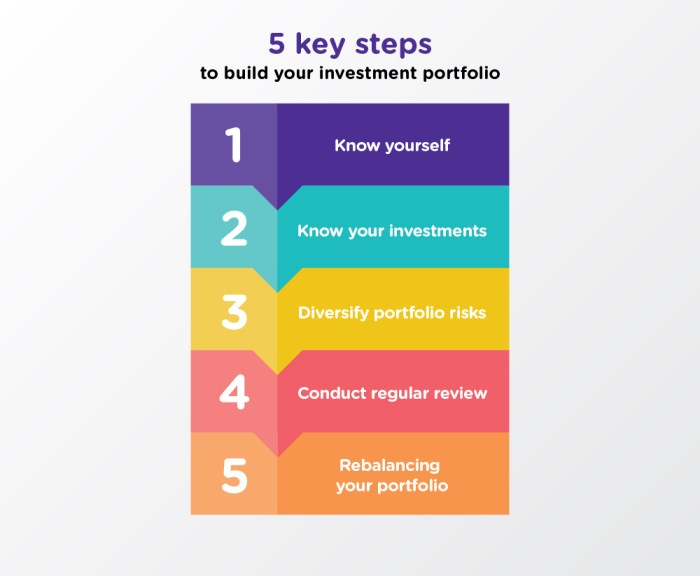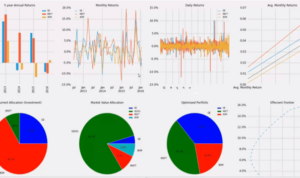Get ready to dive into the world of investment portfolios! From setting goals to assessing risk tolerance, this guide will equip you with the knowledge needed to build a solid investment portfolio that suits your financial objectives.
Understanding the basics of asset allocation, diversification techniques, and investment selection criteria will be key in your journey towards financial growth and stability.
Introduction to Investment Portfolio Building

Investment portfolio is a collection of different types of investments owned by an individual or organization. These investments can include stocks, bonds, real estate, and other assets.
Having a well-diversified portfolio is crucial to reduce risk and increase the potential for returns. By spreading your investments across different asset classes, industries, and geographical regions, you can minimize the impact of a single investment underperforming.
Importance of Diversification
Diversification is the key to building a successful investment portfolio. It helps to spread risk and ensures that your investments are not overly dependent on the performance of a single asset. By diversifying, you can protect your portfolio from market fluctuations and potential losses.
- Diversification reduces the impact of volatility in any one asset.
- It allows you to take advantage of different market conditions.
- Helps to achieve a balance between risk and return.
- Minimizes the chances of losing all your money in case of a market downturn.
“Don’t put all your eggs in one basket.”
Basic Principles of Building a Successful Investment Portfolio
Building a successful investment portfolio involves following some basic principles that can help you achieve your financial goals.
- Set clear investment objectives based on your financial goals and risk tolerance.
- Allocate your assets strategically based on your investment horizon and risk profile.
- Regularly review and rebalance your portfolio to maintain diversification and alignment with your goals.
- Stay informed about market trends and economic indicators that may impact your investments.
Setting Investment Goals
Setting clear financial goals is crucial before building an investment portfolio. These goals help determine the direction of your investments and ensure you stay focused on achieving them. Whether your objectives are short-term or long-term, having a clear plan in place is essential for success.
Short-Term and Long-Term Investment Objectives
When setting investment goals, it’s important to distinguish between short-term and long-term objectives. Short-term goals typically involve saving for a specific purchase or milestone within the next few years, like buying a car or going on a vacation. On the other hand, long-term goals are aimed at achieving financial security and building wealth over an extended period, such as retirement planning or saving for your children’s education.
- Short-term goals require investments with lower risk and higher liquidity to ensure the funds are readily available when needed.
- Long-term goals can tolerate more risk, allowing for potential higher returns through investments like stocks or real estate.
It’s important to align your investment choices with your goals to maximize the likelihood of success.
Risk Tolerance Assessment
When it comes to building an investment portfolio, understanding your risk tolerance is crucial. Risk tolerance refers to the level of uncertainty or volatility an investor is willing to endure when making investment decisions.
Methods for Assessing Risk Tolerance
- Questionnaires: Many financial institutions offer risk tolerance questionnaires that help investors gauge their comfort level with different levels of risk.
- Time Horizon: Assessing how long you have to invest can also impact your risk tolerance. Longer time horizons typically allow for more risk-taking.
- Personal Factors: Consider personal factors such as age, financial goals, and overall financial situation when determining your risk tolerance.
Impact of Risk Tolerance on Portfolio Allocation
- Conservative Risk Tolerance: Investors with a conservative risk tolerance may opt for safer investments such as bonds or certificates of deposit (CDs).
- Moderate Risk Tolerance: Those with a moderate risk tolerance may have a balanced portfolio with a mix of stocks and bonds.
- Aggressive Risk Tolerance: Investors with an aggressive risk tolerance may focus more on high-risk, high-reward investments like stocks or real estate.
Asset Allocation Strategies
Asset allocation is a crucial component of building an investment portfolio as it helps in diversifying risk and maximizing returns. By spreading investments across different asset classes, investors can reduce the impact of market fluctuations on their overall portfolio.
Different Asset Classes
- Stocks: Investing in individual stocks or through mutual funds provides an opportunity for high returns but comes with higher risk.
- Bonds: Fixed-income securities like government or corporate bonds offer lower returns but are considered safer investments.
- Real Estate: Investing in properties or real estate investment trusts (REITs) can provide both income and appreciation potential.
- Commodities: Investing in commodities like gold, silver, oil, or agricultural products can offer diversification and act as a hedge against inflation.
Asset Allocation Guidelines
When allocating assets in a portfolio, it’s important to consider your risk tolerance and investment goals. Here are some guidelines based on different risk profiles:
- Conservative Investors: Those with low risk tolerance may allocate a higher percentage of their portfolio to bonds and cash equivalents to preserve capital.
- Moderate Investors: Investors with a moderate risk appetite may have a balanced allocation between stocks and bonds to achieve growth while managing risk.
- Aggressive Investors: Those comfortable with high risk may allocate a larger portion of their portfolio to stocks and alternative investments for potential higher returns.
Diversification Techniques
Diversification is a crucial strategy in building an investment portfolio as it involves spreading your investments across different assets to reduce risk. By diversifying, you can minimize the impact of a single asset’s poor performance on your overall portfolio.
When it comes to diversification, the benefits extend beyond just reducing risk. Diversifying across different asset classes, such as stocks, bonds, real estate, and commodities, can help you take advantage of various market conditions and economic cycles. Additionally, diversifying within industries can protect your portfolio from sector-specific risks.
Asset Class Diversification
- Allocate your investments across different asset classes, such as stocks, bonds, real estate, and commodities.
- Each asset class reacts differently to market conditions, providing a cushion against volatility.
- For example, when stocks are underperforming, bonds may provide stability in your portfolio.
Industry Diversification
- Invest in companies from various industries to avoid concentration risk.
- For instance, if you only invest in tech stocks, your portfolio could suffer significantly if the tech sector experiences a downturn.
- Diversifying across industries can help mitigate such risks and enhance your portfolio’s stability.
Investment Selection Criteria
When it comes to choosing individual investments for your portfolio, there are several key factors to consider. These factors can help you evaluate opportunities and align your choices with your overall investment strategy.
Fundamental and Technical Analysis
Fundamental analysis involves evaluating a company’s financial health, management team, competitive position, and growth potential. This method focuses on the intrinsic value of an investment and its long-term prospects. On the other hand, technical analysis looks at historical price movements and trading volume to predict future price trends. By combining both approaches, investors can make more informed decisions when selecting investments.
- Fundamental analysis: Involves examining financial statements, industry trends, and economic indicators to assess the value of an investment.
- Technical analysis: Uses charts and historical data to identify patterns and trends that can help predict future price movements.
By using both fundamental and technical analysis, investors can gain a comprehensive understanding of an investment’s potential.
Research and Alignment
Research is crucial when it comes to choosing investments that align with your investment goals and risk tolerance. It’s important to consider factors such as industry trends, company performance, and market conditions. By conducting thorough research, investors can select investments that are in line with their overall strategy and objectives.
- Industry trends: Understanding the current landscape and future outlook of an industry can help identify promising investment opportunities.
- Company performance: Analyzing a company’s financial statements, management team, and competitive position can provide insight into its growth potential.
- Market conditions: Keeping an eye on economic indicators, interest rates, and geopolitical events can help investors make informed decisions based on the broader market environment.
Monitoring and Rebalancing
Regularly monitoring your investment portfolio is crucial to ensure that it aligns with your financial goals and risk tolerance. By keeping a close eye on your investments, you can make informed decisions and take necessary actions to maintain a healthy portfolio.
Importance of Regular Monitoring
- Stay updated on the performance of your investments.
- Identify any underperforming assets or sectors.
- Adjust your portfolio to capitalize on market opportunities.
Rebalancing Your Portfolio
Rebalancing involves realigning your asset allocation back to your original target to manage risk.
- Rebalance annually or when your portfolio deviates significantly from your target allocation.
- Sell overweight assets and buy underweight assets to restore balance.
- Consider tax implications before making any changes to your portfolio.
Adjusting Investments based on Market Conditions
- Buy low and sell high to take advantage of market cycles.
- Stay informed about economic indicators and global events that may impact your investments.
- Review your portfolio during turbulent market periods and make adjustments accordingly.






